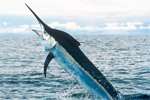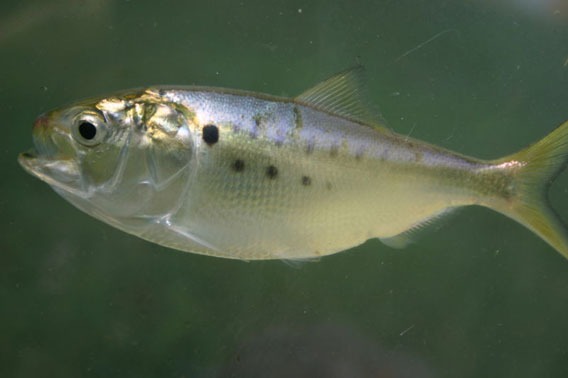Menhaden species in Chesapeake Bay: Brevoortia tyrannus. Photo by: Brian Gratwicke.
The Atlantic State Marine Fisheries Commission (ASMFC) has slashed the allowable catch of a tiny fish named menhaden by 37 percent by 2013. Dubbed the ‘most important fish in the sea’ by author H. Bruce Franklin, the menhaden plays a critical role in marine ecosystems as a food source for larger fish, seabirds, and marine mammals, as well as helping to regulate the marine environment. However, due to overfishing the menhaden fish has dropped 92 percent from its historic population.
Around 80 percent of menhaden is caught by Omega Protein Inc., a company that grinds the tiny menhaden into fish meal for livestock, fertilizer, pet food, and omega-3 fish oil products. The company said it was ‘disappointed’ by the decision and warns it may have to close a plant due to the new catch limits.
However, not all fishermen were unhappy with the decision: some saw it as a way of preserving populations of target fish that feed on menhaden.
While ensuring catch for local fishermen and preserving the environment, the ASMFC also stated the the decision could help tourist industries in the region connected to birders and whale-watchers.
Peter Barker with the Pew Environment Group, which has fought for tougher limits on menhaden for years, called this ‘a watershed moment’.
“Scientists have warned that having too few menhaden in the water could result in disastrous impacts on the fish and wildlife that eat them,” Baker added.
Related articles
First global assessment finds highest-grossing tunas and billfishes most vulnerable to extinction

(11/09/2011) Sleek, powerful tunas and billfishes that ply the open ocean garner some of the highest prices of any fish. In January, a single bluefin tuna fetched a record $396,000 at a Tokyo auction. Yet wild fish populations pay a still higher price for such exorbitant demand: the threat of extinction. The first assessment of an entire group of commercially valuable marine species found that the most threatened fish are generally the ones reeling in the most money, including bluefin tuna and bigeye tuna.
Small marine fish need protection too
(10/25/2011) It has long been known that overfishing has decimated some populations of tuna, shark, cod, as well as other big predatory fish; however two recent studies have pointed out that overfishing is also threatening small fish such as anchovies, sardines, mackerel, herring, menhaden, and krill. Although tiny, these species are vital to marine ecosystems since many species higher up on the food chain—from seabirds to marine mammals to big fish—wholly depend on them for survival.
Fishing industry exceeds Atlantic bluefin quota by 141 percent
(10/18/2011) In 2010 the fishing industry exceeded its quota of eastern Atlantic bluefin tuna (Thunnus thynnus) by 141 percent, according to a new analysis by Pew Environment Group. The analysis depends on official data, thereby leaving out the massive black market on Atlantic bluefin tuna.
